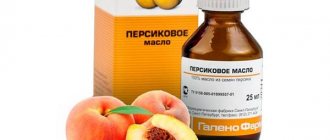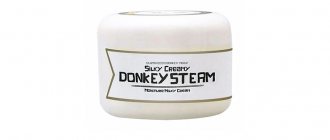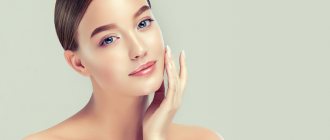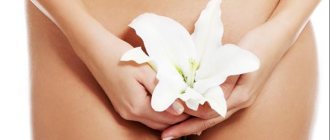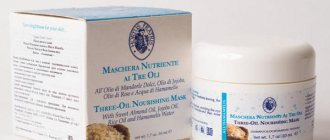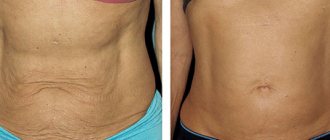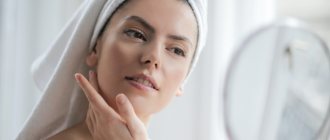Collagen is one of the proteins in our skin, it is also called the “protein of youth”. This is because it, in tandem with elastin, provides firmness and elasticity to the skin, acting as a “springy mattress”.
After 45 years, the body reduces collagen production to almost zero. The rest of a person's life lives on supplies made before this age.
There are more than 20 types of collagen, but types I and III are the most important for good skin condition.
Who produces collagen and who destroys it?
Collagen in the skin is synthesized by special cells - fibroblasts , but it is destroyed due to the action of enzymes. These two processes are constant, but with age (after 35 years) destruction begins to prevail over synthesis: elastic fibers are destroyed, become hard and brittle, damaged, fragmented collagen accumulates in the skin.
This leads to the skin losing strength and elasticity, becoming flabby, drying out due to the loss of protein’s ability to retain moisture, and wrinkles forming.
Young skin (up to 30 years) synthesizes about 6 kg of collagen per year; after 35 years, this figure drops to 3 kg, and then continues to decrease year by year.
How to get collagen back?
The first thing you hear is advice on optimizing your diet. It is believed that the diet needs to be varied:
- vitamins C, A, D;
- peptides (collagen building material);
- retinoids (stimulants of fibroblasts).
But artificial collagen is also often mentioned: it can be of animal origin (allergenic and is not used), plant origin (can also cause allergies and has virtually nothing in common with the original protein) and marine origin.
Artificial collagen in creams, masks and dietary supplements
The problem with artificial collagen for external use ( in creams, gels, masks ) is that the large protein molecule does not penetrate the stratum corneum of the skin, but only temporarily fills unevenness and microcracks on its surface.
The apparent effectiveness of the drugs is explained by the moisturizing effect. It occurs as a result of the formation of a film on the surface of the skin, which makes it difficult for the evaporation of water from the upper layers of the epidermis.
Food supplements are also widely advertised , but these drugs have virtually no effect on the condition of the skin, since in its finished form the protein is difficult to absorb from the digestive tract.
Type I and III collagen, neither in the form of pills nor in the form of creams, does not reach the deep layers of the dermis. How to restore elasticity and youth to the skin?
It is important to understand that “ready-made” collagen will not greatly help the skin gain elasticity and density, because the substance of the native “human” type has not yet been synthesized .
Creams and dietary supplements use “marine” collagen , which the body still needs to integrate into the structure of the skin; this process occurs due to the destruction of the protein itself, separation into constituent amino acids and hydroxyprolines (don’t remember these words!). What is the point of injecting “ready-made” collagen into the skin for it to break down there?
Myths about collagen
From all corners of the Internet, cosmetologists shout with one voice that aging is associated with a reduction in the level of collagen in the dermis. We are convinced that we need lots and lots of new protein to stay young. As a means of salvation, they offer collagen injections, cosmetics, dietary supplements, which are supposedly capable of filling our skin with collagen in incredible quantities.
How much of this is true? NOTHING.
Myth: Collagen in the skin decreases with age, so it needs to be replenished.
Fact: Collagen accumulates in the skin over the years in the form of clumped fibers and debris, creating a lifeless, dense web. Its amount becomes critical and prevents nutrients and moisture from accumulating in the intercellular matrix and reaching the cells.
That's why:
- Our skin doesn't need more collagen than it has.
- On the contrary, its task is to get rid of the accumulated collagen “ballast”.
- For youth, it is not the quantity, but the quality of collagen that is important.
- Injections, creams, and dietary supplements containing collagen do not work.
- The most effective way to improve the quality of your own collagen is self-massage + a healthy lifestyle.
Now let's talk about everything in order.
Effective skin rejuvenation can be achieved in two ways:
- delivery to the dermis of substances that stimulate the natural production of collagen, preferably not only types I and III (types IV, V, and VII are also important, for example);
- stimulation of fibroblasts so that they don’t become lazy after 30 years and continue to produce collagen as they did at 18.
Building material can be delivered to the skin in two ways: by adding the necessary elements to the diet or by performing an injection procedure (introducing the necessary elements using injections). The first way takes longer and has a cumulative effect, the results of the second can be assessed almost immediately after the procedure.
In order for your skin to be healthy and youthful, your diet must include:
- vitamin C in sufficient quantities;
- copper (cod liver, spinach, cocoa powder, beef liver);
- pyridoxine (vitamin B6): pistachios, garlic, beans;
- zinc (oysters, wheat bran, eel, sesame);
- sulfur-containing compounds - sulfur, glutamine (rabbit, chicken breast, turkey, egg powder);
- selenium (pistachios, walnuts, beans and lentils, broccoli, tuna);
- silicon (unpolished rice, oats, millet, barley).
Let us separately note those compounds and substances that stimulate the work of fibroblasts :
- vitamin A (fish oil, beef liver, carrots);
- vitamin D (fish oil, cod liver, fatty fish, seafood);
- peptides.
If you manage to create a diet of all the listed products with minor deviations, after 6-9 months your skin condition will noticeably improve!
What types of collagen are there?
Where does collagen come from, which is used in cosmetics and injections?
On an industrial scale, they learned to obtain it from three sources:
- Animal collagen.
Extracted from the skin of pigs and cattle. It's the cheapest. But today such collagen is prohibited from being used in cosmetics due to its aggressiveness and foreignness. There is a high risk of infection and allergies. You can add it to dietary supplements. - Collagen of plant origin.
This is more of a catchy metaphor than the truth. Plants do not produce collagen. And what is called collagen is a hydrolyzed protein - an artificial substance that is created on a plant base. Typically these are wheat proteins and algae. Production is difficult and expensive. - Marine collagen.
Extracted from fish skin. This is the closest option to a person, but still alien. Collagen from marine fish is considered an allergen, but not from freshwater fish.As we see, there is no choice. The first type of collagen is prohibited, the second is not collagen. Only fish remain.
Differences between collagen types I and III
We found out that all kinds of dietary supplements with collagen are useless for the skin. Only natural products are effective, although you should not refuse the help of cosmetologists.
So, how can our specialists help?
To begin with, we note that cosmetologists see significant differences between type I collagen and type III collagen :
- collagen type I (fibrous) predominates in the skin composition (about 60%), has an uneven and dense structure;
- Type III collagen (reticular) is the most desirable because it is responsible for the youth of the skin, its fibers are smooth, slender, with excellent elasticity.
When damaged, type III protein turns into type I. For example, our scars and scars are made entirely of type I collagen.
Why is it needed?
Collagen supports the skin from the inside, like springs support a mattress. He is responsible for its strength and elasticity. That is, the skin is not damaged when stretched and does not change its structure precisely thanks to collagen. It seems to “spring”: it stretches and returns to its original shape.
This fixing role of collagen is also indicated by its name. From Greek kola – “glue”, gen – “to create”.
Collagen depends on:
- skin elasticity,
- tightened oval,
- smooth relief without wrinkles,
- shape and proportions of the face.
But what exactly happens to collagen when age-related changes begin? Most of us don't know the answer to this question. Instead, they believe in dangerous myths that are spread by cosmetologists.
Stimulating collagen production
The cosmetologist’s task is to stimulate the formation of elastic fibers of type III, although the older the patient, the more difficult it is to “awaken” and “stimulate” fibroblasts. There are studies proving the impossibility of synthesizing “youth collagen” in old age after 65 years. This means that you need to stock up on “young” collagen in advance!
- Procedure mesotherapy.A series of injections with a thin needle or cannula, during which the necessary substances for collagen synthesis are introduced into the skin, as well as peptides with amino acids to irritate and stimulate fibroblasts. The effect is the same as from 3-4 months of an enhanced “collagen-stimulating” diet!
The entire face requires at least 2 ml of the drug (preferably 3-4)! This is the case when the desire to save money can lead to lack of results and disappointment.Cannulas can be used to perform papular mesotherapy (so-called bioreparation), but the injection technique is better and more effective.
- Mesoradiesse procedure (RD or RHD) is a procedure for strengthening (bio-reinforcement) of the skin with Radiesse . A dense white preparation is diluted with saline and injected into the middle layers of the skin in the form of a “lattice”.
What's the point? Radiesse contains calcium hydroxyapatite (this substance is part of our skeletal system, that is, not foreign to the body). Radiesse microspheres introduced into the skin cause skin macrophages to activate (as a response to external influences). In turn, macrophages, which actively destroy calcium hydroxyapatite, stimulate fibroblasts to synthesize new collagen, and studies have confirmed the presence of newly synthesized type III collagen at the sites of drug administration. - The radiofrequency lifting procedure ( RF-lifting ) uses the properties of protein to “shrink” under the influence of temperature and other influences (remember what happens when you cut meat in a frying pan - it decreases in size).
After exposure of the skin to RF radiation, the chains of collagen and elastin inside the skin are compressed and rolled up, providing a lifting effect. During irradiation, type III collagen is damaged and over time “transforms” into the fibrous type. The RF lifting procedure does not stimulate the production of new collagen: during temperature exposure, only a change in the type of collagen in the dermis occurs, and not a very desirable one. - Plasma therapy is the introduction of the patient’s enriched plasma into the deep layers of the skin. It allows you to start the process of neocollagenesis due to the same stimulation of fibroblasts, however, for better results, it is recommended to combine the procedure with mesotherapy.
How are age-related changes related to collagen?
Age-related changes are explained precisely by the quality of collagen, which deteriorates over the years. Its fibers become damaged, break, and stick together. And all this “garbage” accumulates.
The extracellular matrix is “cluttered” with protein fragments and cross-links. This is no longer a frame, but a “cemetery” of “dead” collagen (+ elastin). The stitches tighten the face with a dense network. The dermis seems to stick together with the covering layer, blocking the mobility and interaction of tissues with each other.
Such accumulations of damaged collagen are ballast that turns the fluid extracellular matrix into a dense, lifeless mass. In it, cells lose their former mobility and cease to receive moisture and nutrients in the same quantities (since the pathways are blocked by “clogs” of collagen cross-links and debris).
Wrinkles, sagging and roughening of facial skin are external manifestations of the fact that our face is covered with a tight web of lifeless collagen (+ elastin).
The accumulation of old, “dead” collagen and the reduction in the production of new, “live” collagen are two interrelated processes. The fact is that collagen is synthesized by fibroblast cells, and they can only work on whole collagen threads. What if instead of them there are fragments? Then the production of new fibers is disrupted.
Do you want to “revive” and renew your collagen? Come to the “Flourish” marathon from MelAnnett.
Daily routine, sleep and hormones
Collagen synthesis is impossible without the support of hormones. Thus, the process of neocollagenesis is influenced by sex hormones, the receptors for which are found in fibroblasts. The production of “youth protein” depends on the percentage of estrogen in the body, so in menopausal women, when the amount of female sex hormones sharply decreases, negative changes in the skin also occur. But the main hormone responsible for collagen synthesis is somatotropin . It is notable for its daily rhythms of secretion. The highest and most predictable peak in growth hormone production occurs at night, usually 2 hours after falling asleep. However, a number of studies show reduced rates of hormone secretion in people who go to bed after 1 am (the so-called “night owls”). Therefore, it is generally accepted that the most favorable hours for restoring the beauty of the skin are the interval between 11 pm and 1 am.
Why do you need this knowledge?
After the Radiesse biostimulation procedure or mesotherapy, at least for 2-3 months after it, try to go to bed no later than 21-22 o'clock at night. In combination with a “collagen-stimulating diet,” this approach will allow you to achieve impressive results and maintain the rejuvenation effect for a long time.
Why does our body need collagen?
Collagen is a vital protein
As mentioned above, collagen is responsible for the elasticity of connective tissue and skin. Thanks to this substance:
- maintains elasticity and firmness of the skin; beauty and health of hair and nails;
- joint mobility and ligament strength are maintained;
- the walls of blood vessels are strengthened.
The lack of this protein affects a person’s appearance and overall well-being. Collagen deficiency may be indicated by:
- deterioration of skin condition, appearance of wrinkles;
- thinning of the walls of blood vessels, their rupture;
- atherosclerosis;
- decreased visual acuity;
- the occurrence or exacerbation of various joint diseases;
- flaking, brittleness, dull appearance of hair and nails;
- decreased muscle strength, decreased bone and joint density;
- feeling tired for no apparent reason;
- the appearance of intestinal problems (for example, frequent constipation).
Thus, collagen is necessary for the normal functioning of various organs and systems of our body. Therefore, it is so important to avoid its deficiency.
Contraindications
Collagen supplements are considered safe for most people and have virtually no contraindications. However, some of them are produced using common food allergens - eggs, cow's milk, fish, seafood, nuts, wheat, soy. Therefore, before taking such drugs, you should always carefully study their composition. If you have an individual intolerance to any of the components of a food supplement, you will have to stop taking it and find a safer analogue.
Collagen should also be taken with caution by people who suffer from kidney failure and liver diseases. An excess of protein in the diet significantly increases the load on these organs. Pregnant and lactating women can use collagen supplements only under strict medical supervision.
In addition, in some cases, collagen supplements can leave an unpleasant taste in the mouth, cause heartburn and a feeling of heaviness.
Collagen fillers: types, similarities and differences.
Injection cosmetology today is one of the main areas of modern aesthetic medicine. The demand for injection procedures is explained by their high efficiency and long-lasting results. With the help of injections, it is possible to improve the quality of the skin, eliminate its imperfections, correct age-related changes and missing volumes. The procedure of contour plastic surgery, which is based on the use of special filler preparations that correct contours and volumes, is especially popular among patients.
Collagen fillers are one of the first drugs used in anti-aging injection medicine. Back in the 70s, the first attempts were made to use fillers based on animal collagen, but they were not always successful, because animal protein was perceived by the human body as foreign.
It is important to note that the injection technique of that time prescribed the use of a “point method”. That is, collagen rejuvenation should be carried out carefully, gradually, and in general such therapy took from 3 to 18 months. During this period, doctors repeated collagen injections in extremely small doses, as they were afraid of the development of allergic reactions and related complications. However, after collagen fillers were approved by regulatory authorities, the protocol for administering collagen fillers was changed, which led to an increase in the number of allergic reactions and other complications.
Collagen fillers, incl. and animal origin, are used in modern aesthetic medicine, however, such drugs are highly purified and safe for the patient, and are used only after a thorough allergy test.
Collagen filler injections are optimal for those patients who want to get the longest possible effect of correcting facial contours, but at the same time do not have large funds.
In modern cosmetology, two types of collagen fillers are most often used:
— collagen fillers obtained from bovine fibroblasts. These fillers are based on xenogeneic bovine collagen, which undergo special processing, because... animal proteins are foreign to the human body, and as a result of their introduction into the skin, a number of complications may arise;
— collagen fillers obtained from human cell cultures. These fillers are based on autogenous human collagen, which is much better accepted by the body, but such fillers are used much less frequently in cosmetology.
The procedure for injecting collagen fillers into the skin is no different from similar procedures using other fillers. The patient's skin is pre-treated with an antiseptic, after which the filler is injected into the dermis. In the skin, collagen molecules are separated from the physiological solution, which performs a transport function, and implanted into the dermis. The timing of implantation depends on the individual characteristics of the patient’s body, but the result of the injection is always the smoothing of the skin surface. Foreign collagen subsequently submits to the natural aging processes - this means that such a filler cannot be considered permanent, but its action will be somewhat longer than that of hyaluronic or calcium hydroxyapatite.
The rejuvenation procedure is carried out in several stages; on average, about three injections are required, carried out at intervals of a month. The validity period is about a year, depending on the individual characteristics of the patient.
The use of collagen fillers has several important advantages, the first among which is the lower cost of the procedure, as well as the duration of the effect. Using collagen fillers, you can correct facial wrinkles, insufficient volume of lips and cheekbones, pronounced nasolabial folds, irregular chin shape, post-acne scars and other imperfections in skin texture.
Contraindications to the introduction of collagen fillers include the presence of any disorders of immune function, inflammatory skin diseases in the treatment area, and pregnancy.
Complications after injection of collagen fillers are most often associated with the immune response - cystic or nodular formations, granulomatous lesions. Unpredictable allergic reactions can in many cases be prevented by using a dual testing system.
One of the latest developments is collagen-based fillers with polymethyl methacrylate microspheres. Microspheres, entering the dermis, stimulate collagen synthesis. Microspheres can remain in the skin indefinitely and never dissolve. Microspheres enclosed in “jelly” transform the self-absorbing collagen filler into a permanent one, that is, if you have already decided on such injections, they will remain with you forever. On the one hand, this is of course good, since you don’t have to spend money on constantly “feeding” wrinkles and folds. But on the other hand, permanent fillers have a high rate of complications and are unpredictable compared to biodegradable ones.
If the optimal option for the patient is to inject collagen fillers, it is necessary to check his body’s reaction to collagen in order to avoid possible negative consequences.
For training issues: Lyudmila; +79219015105; email Consultation on medications: Oksana, +79119952960; e-mail We will be glad to see you at the address: Ushinskogo street, building 3, building 3, St. Petersburg.
Sources: https://cosmetic.ua/, https://estet-portal.com/.
Japanese collagen from AFC 1000
The food supplement AFC Collagen starts the regeneration processes of the dermis. With regular use of the product:
- the body activates its own collagen production processes;
- the firmness and elasticity of the skin is restored;
- The visibility of wrinkles and open pores is reduced.
The dietary supplement is available in the form of tablets. In addition to collagen, the product contains shark cartilage extract, which increases skin elasticity and vitamin C, which enhances the synthesis and speed of absorption of collagen.
Mechanism of collagen formation
Connective tissue cells - fibroblasts - synthesize the intercellular matrix, which includes collagen. Amino acids are needed to build the fibrillar protein collagen. Glycine, proline and lysine are combined into triads in a certain sequence, and then form polypeptide chains interconnected in the structure by a triple superhelix. In this way, a strong and elastic collagen fibril is formed.
To carry out complex biochemical transformations, enzyme co-factors, vitamins and minerals are required. The formation of collagen involves vitamins: C, D, F, E, A and trace elements: zinc, sulfur, silicon, copper and iron, as well as pigments: anthocyanins, lutein. Only with a sufficient intake of all these substances from food will the body be able to synthesize its own collagen. Considering that approximately 40% of all peptides in the human body are collagen, it is important to have plenty of protein in your diet.
How to influence the synthesis of connective tissue to increase collagen levels?
This question interests users. But only people who have become victims of cosmetologists’ propaganda can put it this way. As we have already found out, collagen levels DO NOT NEED to be increased. This will only increase the collagen “clog.”
On the contrary, our task is to cleanse the extracellular matrix of collagen fragments and cross-links. “Break through” the thick and impenetrable web that they form. Replace the incorrect collagen, which prevents moisture and nutrients from reaching the cells, with the correct one, with intact, strong, separate fibers.
Cosmetological methods of neocollagenesis
So far we have only talked about different ways of adding collagen to the skin from the outside. But in aesthetic medicine there is another fashionable and branched direction - neocollagenesis. This term refers to the activation of fibroblasts and collagen renewal using a number of hardware and invasive techniques.
There are three main cosmetic methods to “stir up” fibroblasts:
- Remove the top layer of the dermis
(laser and mechanical dermabrasion). Then fibroblasts will begin to “patch” the damaged area, “growing” new collagen. This is an aggressive and dangerous path that leads to tissue injury and leads to the formation of an unhealthy collagen “wall” instead of a framework. - Create a thermal burn
(RF lifting, laser lifting, thermage). The upper layers of the dermis heat up, the cells “sinter,” and the collagen fibers shrink and become denser. Externally, this short time may look like tightened skin. But what really happened? The skin has grown fibrous formations. The scars covered the intercellular matrix with a dense layer, fiber to fiber, and left no room for either vessels or fluid movement. “Hungry” cells + frozen, “lifeless” matrix = accelerated skin aging. - Injure the skin with multiple injections
(mesotherapy, biorevitalization, lipofilling). Several dozen and hundreds of injections are given to the face in one procedure, and many sessions are required. Due to total injury from needles, new collagen grows in the dermis. But not the one we need, but the unhealthy, fibrous one. It binds the intercellular matrix and prevents cell trophism. The skin may be transformed and tightened for a short time, but pathological processes occur inside it, and this will soon result in premature aging.
What is the order of application?
Daily application of cream
Be sure to apply daily cream to clean skin for firmer, tighter, repaired, remodeled skin. Correct movements: Bend your fingers into hooks, spread your index and middle fingers, and place them at chin level to smooth and tighten the skin along the jaw towards the ears.
Caring for the skin around the eyes
If your eye area is prominent and your eyelids feel heavy, complement your routine with a special eye cream formulated for the delicate eye area. This will allow you to tighten the skin around your eyes and lift your eyelids. Correct movements: during application, touch and tap your eyelids with your fingertips. If necessary, this product is also applied to the upper eyelid.
Serum
Taking it a step further, a serum is the perfect way to improve your skin's elasticity and prepare it for cream application. Correct movements: after application, perform tapping movements on the skin so that the serum is absorbed faster and stimulates microcirculation.
Program
For intense effects, you can periodically carry out a remodeling program to gradually restore the effect. After 21 days, facial skin becomes more elastic and regains its shine. Correct Movement: Apply full dose every evening for 21 consecutive nights, replacing night cream.
- Smooth, light, slow movements of the hands from the inside out.
- Go down to the neck.

